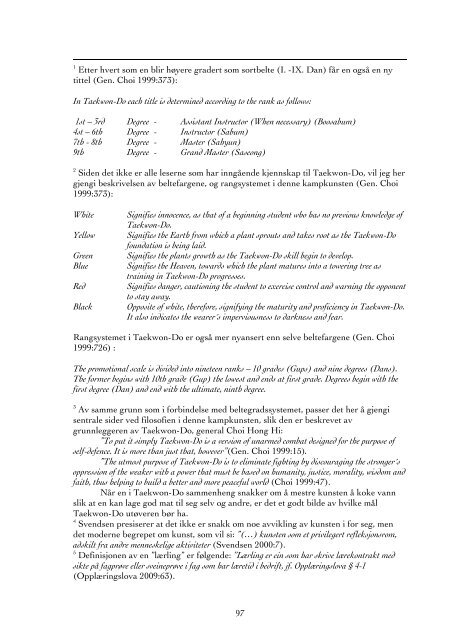Kunsten å koke vann - Munin - Universitetet i Tromsø
Kunsten å koke vann - Munin - Universitetet i Tromsø
Kunsten å koke vann - Munin - Universitetet i Tromsø
You also want an ePaper? Increase the reach of your titles
YUMPU automatically turns print PDFs into web optimized ePapers that Google loves.
1 Etter hvert som en blir høyere gradert som sortbelte (I. -IX. Dan) f<strong>å</strong>r en ogs<strong>å</strong> en ny<br />
tittel (Gen. Choi 1999:373):<br />
In Taekwon-Do each title is determined according to the rank as follows:<br />
1st – 3rd Degree - Assistant Instructor (When necessary) (Boosabum)<br />
4st – 6th Degree - Instructor (Sabum)<br />
7th - 8th Degree - Master (Sahyun)<br />
9th Degree - Grand Master (Saseong)<br />
2 Siden det ikke er alle leserne som har inng<strong>å</strong>ende kjennskap til Taekwon-Do, vil jeg her<br />
gjengi beskrivelsen av beltefargene, og rangsystemet i denne kampkunsten (Gen. Choi<br />
1999:373):<br />
White Signifies innocence, as that of a beginning student who has no previous knowledge of<br />
Taekwon-Do.<br />
Yellow Signifies the Earth from which a plant sprouts and takes root as the Taekwon-Do<br />
foundation is being laid.<br />
Green Signifies the plants growth as the Taekwon-Do skill begin to develop.<br />
Blue Signifies the Heaven, towards which the plant matures into a towering tree as<br />
training in Taekwon-Do progresses.<br />
Red Signifies danger, cautioning the student to exercise control and warning the opponent<br />
to stay away.<br />
Black Opposite of white, therefore, signifying the maturity and proficiency in Taekwon-Do.<br />
It also indicates the wearer´s imperviousness to darkness and fear.<br />
Rangsystemet i Taekwon-Do er ogs<strong>å</strong> mer nyansert enn selve beltefargene (Gen. Choi<br />
1999:726) :<br />
The promotional scale is divided into nineteen ranks – 10 grades (Gups) and nine degrees (Dans).<br />
The former begins with 10th grade (Gup) the lowest and ends at first grade. Degrees begin with the<br />
first degree (Dan) and end with the ultimate, ninth degree.<br />
3 Av samme grunn som i forbindelse med beltegradssystemet, passer det her <strong>å</strong> gjengi<br />
sentrale sider ved filosofien i denne kampkunsten, slik den er beskrevet av<br />
grunnleggeren av Taekwon-Do, general Choi Hong Hi:<br />
”To put it simply Taekwon-Do is a version of unarmed combat designed for the purpose of<br />
self-defence. It is more than just that, however”(Gen. Choi 1999:15).<br />
”The utmost purpose of Taekwon-Do is to eliminate fighting by discouraging the stronger´s<br />
oppression of the weaker with a power that must be based on humanity, justice, morality, wisdom and<br />
faith, thus helping to build a better and more peaceful world (Choi 1999:47).<br />
N<strong>å</strong>r en i Taekwon-Do sammenheng snakker om <strong>å</strong> mestre kunsten <strong>å</strong> <strong>koke</strong> <strong>vann</strong><br />
slik at en kan lage god mat til seg selv og andre, er det et godt bilde av hvilke m<strong>å</strong>l<br />
Taekwon-Do utøveren bør ha.<br />
4 Svendsen presiserer at det ikke er snakk om noe avvikling av kunsten i for seg, men<br />
det moderne begrepet om kunst, som vil si: ”(…) kunsten som et privilegert refleksjonsrom,<br />
adskilt fra andre menneskelige aktiviteter (Svendsen 2000:7).<br />
5 Definisjonen av en ”lærling” er følgende: ”Lærling er ein som har skrive lærekontrakt med<br />
sikte p<strong>å</strong> fagprøve eller sveineprøve i fag som har læretid i bedrift, jf. Opplæringslova § 4-1<br />
(Opplæringslova 2009:63).<br />
97

















